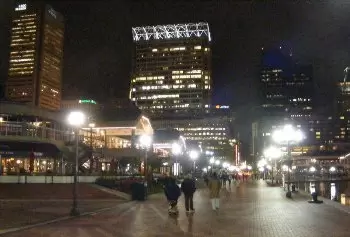Indian cities need to grow smart

14-July-2012
Vol 0 | Issue 1
I walked into Shopper's Stop on Bannerghatta Road, Bangalore. Even before I got into the store, I found an element that intrigued my urban planning senses. Outside the store was a little space where there were scores of people enjoying an ice candy or an ice cream or some tidbits of snacks.
Most of the people there seemed to have driven in to the store, while some of them had walked in solely to enjoy a small treat. There were no designated seating spaces and people were sitting on ledge walls and steps and anything they could find habitable for the moment.
 |
|
Baltimore's famous Inner Harbor (Photo: Aparajithan N)
|
That probably explained the lack of a bigger crowd on a rather pleasant Saturday evening. What I had stumbled upon was in fact an accidental urban space that provided a small solace to a handful enjoying an evening stroll through the town on a busy thoroughfare.
Having lived and worked in downtown Baltimore and more than enjoyed the pleasures of Baltimore's famous Inner Harbor, such an accidental discovery entrenched in me the almost tragic state of Indian cities.
The Indian cities lack public spaces, as in the west. If not for the beaches, Chennai would be the most boring place on earth, for instance. It still is for the most part because getting to the beaches is more than a chore these days even with the most comfortable private transportation means at our disposal.
Public spaces define the attractiveness of a city in terms of its built environment and Indian cities are defined, if anything, by the lack of such public spaces.
Consequently, we have private spaces such as shopping malls masquerading as public spaces.
A public space by definition is one where you would not have to pay any money to spend a couple of hours.
Why this dearth of public spaces and what is the significance of this discussion with regards to the future of Indian cities?
For all the beauty of the Inner Harbor, this malaise of shopping malls and other private spaces taking over the need for a public space probably emanated in America with their interstate highway system, suburban utopia and the ubiquitous automobile.
For fifty long years with the birth of Eisenhower's interstate highway system suburban development and segregated zoning prospered with financial institutions more than glad to sing to the tunes of the potential high returns in the short term for such development patterns.
Cities grew from a concentration of tall buildings to being a notional figurehead for an entire region and in the process they have submerged the identities of neigbouring towns. Formerly flourishing towns have completely lost themselves in the din of monstrous cities.
The factor responsible for the growth and attractiveness of suburban areas was the overcrowding of cities.
While development is good, overcrowding is counterproductive and at most times detrimental to sustenance.
Indian cities border on the overcrowded and hence, the suburbanization and growth of the city is inevitable especially considering the size of our population. But the challenge lies in promoting ‘Smart Growth’.
For the smart growth of Indian cities, we need the following – efficient means of transporting men and materials, balance between increasing our development footprint and maintaining ecological symbiosis and a healthy quality of life.
Sustainable development is defined as the simultaneous and continuous economic, environmental and cultural development over generations.
As can be seen from the West, personal vehicles and huge highways are not the answer for efficient transportation. Apart from the overcrowded highways, yes even eight lane highways can get clogged, the West is full of evidence of communities eviscerated by these highways.
Boston’s Big Dig and even Seoul removed an elevated highway to make way for a public plaza. The answer lies in efficient public transportation, promoting large public plazas and preserving the natural environmental resources to the best possible extent.
But look at the Indian scenario. Chennai, for instance, luckily, has vast resources of lakes, hills, and if nothing else scores of man-made parks and gardens. Unfortunately, these are used as either dump yards or for making concrete.
Some parks are preserved, but the numbers are nowhere close to what is required for an effective quality of life throughout the city.
Dividing the city region into nodes connected by mass transit corridors can help in maintaining a scale for a city that is humane while maintaining the convenience and economy of a big city, and help in curbing indiscriminate growth and proliferation of senseless communities that are in the middle of nowhere and connected to no place!
In this five part article, I would be trying to present a vision for Chennai – which can be replicated in any other Metro with relevant modifications - from the view point of sustainable development.
We will look at the mistakes cities have made in the past and how they have corrected themselves to continue being a significant name in the current world, and how Chennai is committing or about to commit or could easily avoid such mistakes.
We will also be looking at some successful stories from other parts of the world which could be applied to Chennai to make it more vibrant, livable and sustainable.
Aparajithan N is Principal Architect at AN Projects Design Pvt Ltd, Chennai















